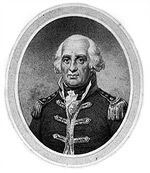Name Henry Ball | ||
 | ||
Died October 22, 1818, Surrey, United Kingdom | ||
Henry Lidgbird Ball (1756–1818) was a Royal Navy officer, best known for discovering and exploring Lord Howe Island.
Contents
Early life
The son of George Ball, gentleman, and his wife Lucy, he was baptised on 7 December 1756 at Woodchurch, Cheshire.
Career
In 1788, having previously commanded HMS Supply, Lieutenant Ball commanded the vessel entrusted with shipping the first group of settlers from Botany Bay to Norfolk Island.
Between 1788 and 1790, Ball explored the area around Port Jackson and took part in the capture of the Aborigine, Arabanoo, on 31 December 1788, in addition to revisiting Lord Howe's Island, as it was then known, and Norfolk Island.
After falling ill in January 1791, Ball returned to England to convalesce. Leaving Australia in November 1791, he landed at Plymouth in April 1792 with the first kangaroo to be shipped to England on board his ship.
Ball returned to duty in December 1792 and was made a captain in 1795, in which position he served with distinction between 1795 and 1812, commanding HMS Daedalus at the Action of 9 February 1799 and capturing the French frigate Prudente. In 1812 he went onto half pay in semi-retirement. On 4 June 1814 Ball was promoted to Rear Admiral of the Blue.
In the summer of 1809 he was called as a witness at the Court-martial of James, Lord Gambier which assessed whether Admiral Lord Gambier had failed to support Captain Lord Cochrane at the Battle of Basque Roads in April 1809. Gambier was controversially cleared of all charges.
Personal life
During his time in Australia, Ball had a relationship with Sarah Partridge (also known as Mary Stokes), a convict who had been transported by the First Fleet in the Lady Penrhyn. They had a daughter, Anne Maria (born 1789).
On 17 June 1802 Ball married Charlotte Foster in London; she died a year later. On 19 July 1810, at Kingston upon Thames, he married Anne Georgianna Henrietta Johnston, who was 31 years younger than he was: she survived him and died in 1864.
Death and legacy
He died on 22 October 1818 at Mitcham (then in Surrey and now in London), England. He was buried in the churchyard at St Peter's Church, Petersham, in the family vault of his wife Anne Georgianna Henrietta Johnston. A commemorative plaque marking Ball was added to the Johnston tomb on 20 October 2013 at a service attended by the Australian High Commissioner to the United Kingdom.
Ball's Pyramid, Mount Lidgbird, Ball Bay on Norfolk Island and (possibly) Balls Head on Sydney Harbour are all named after him.
